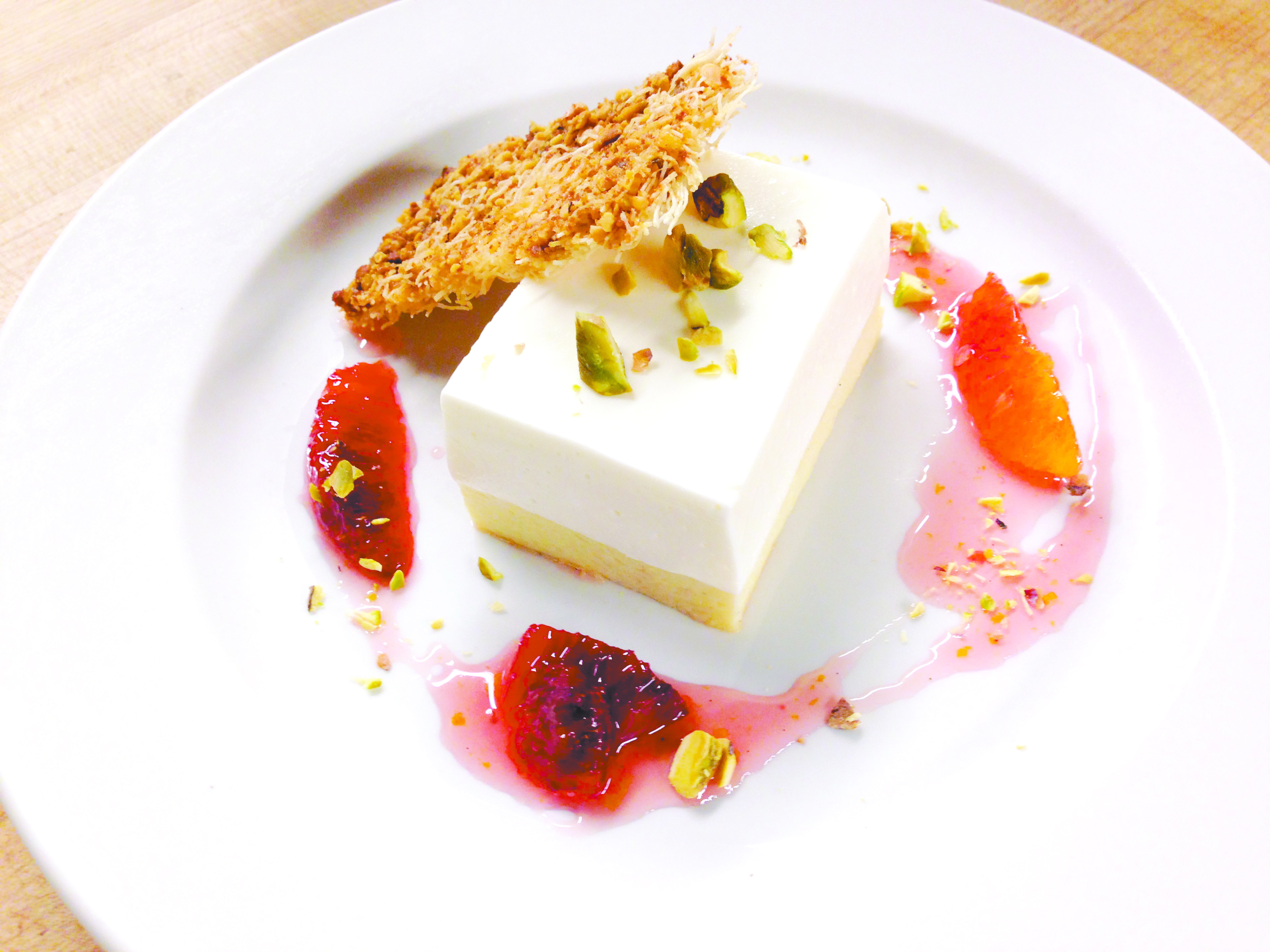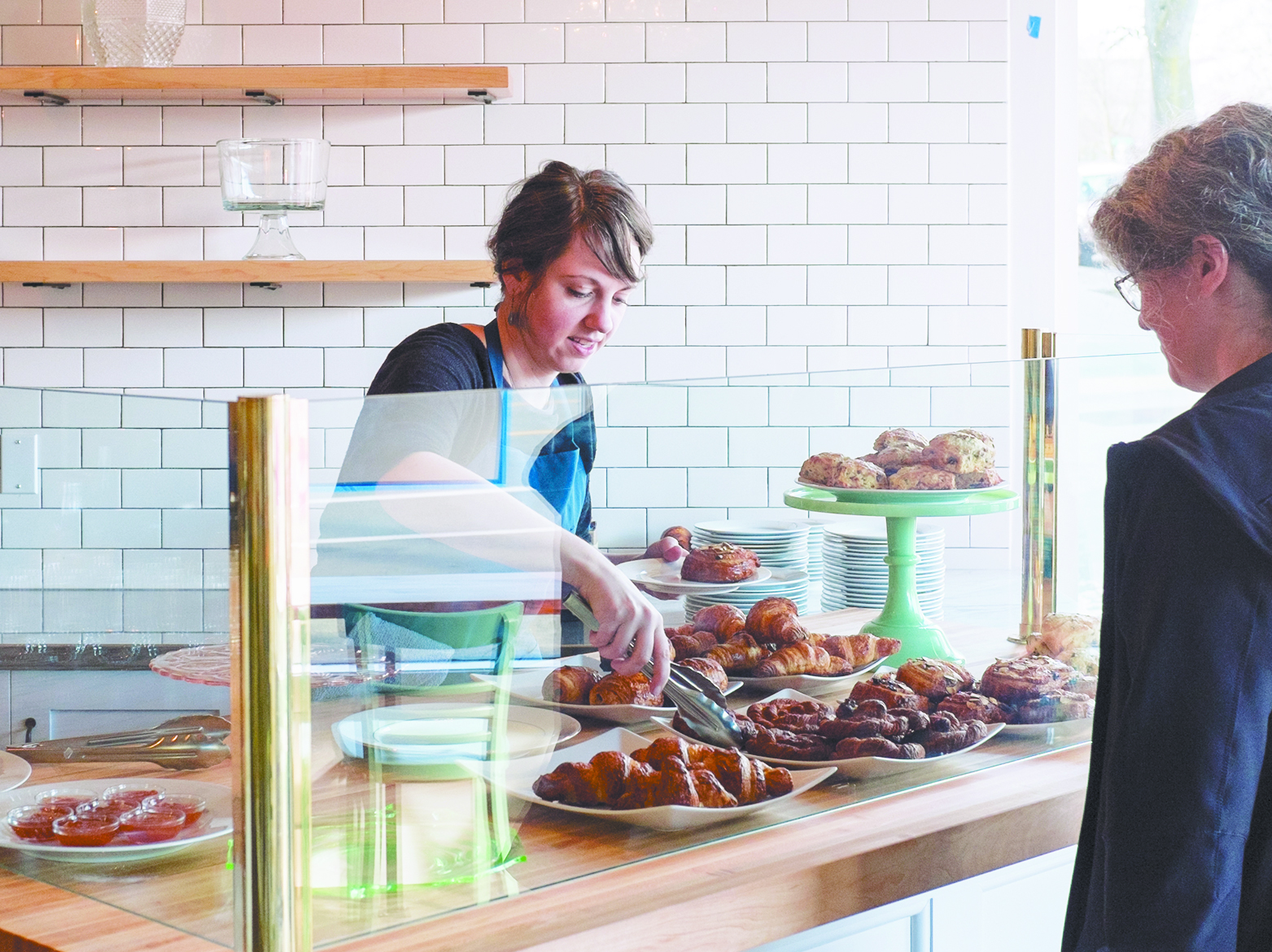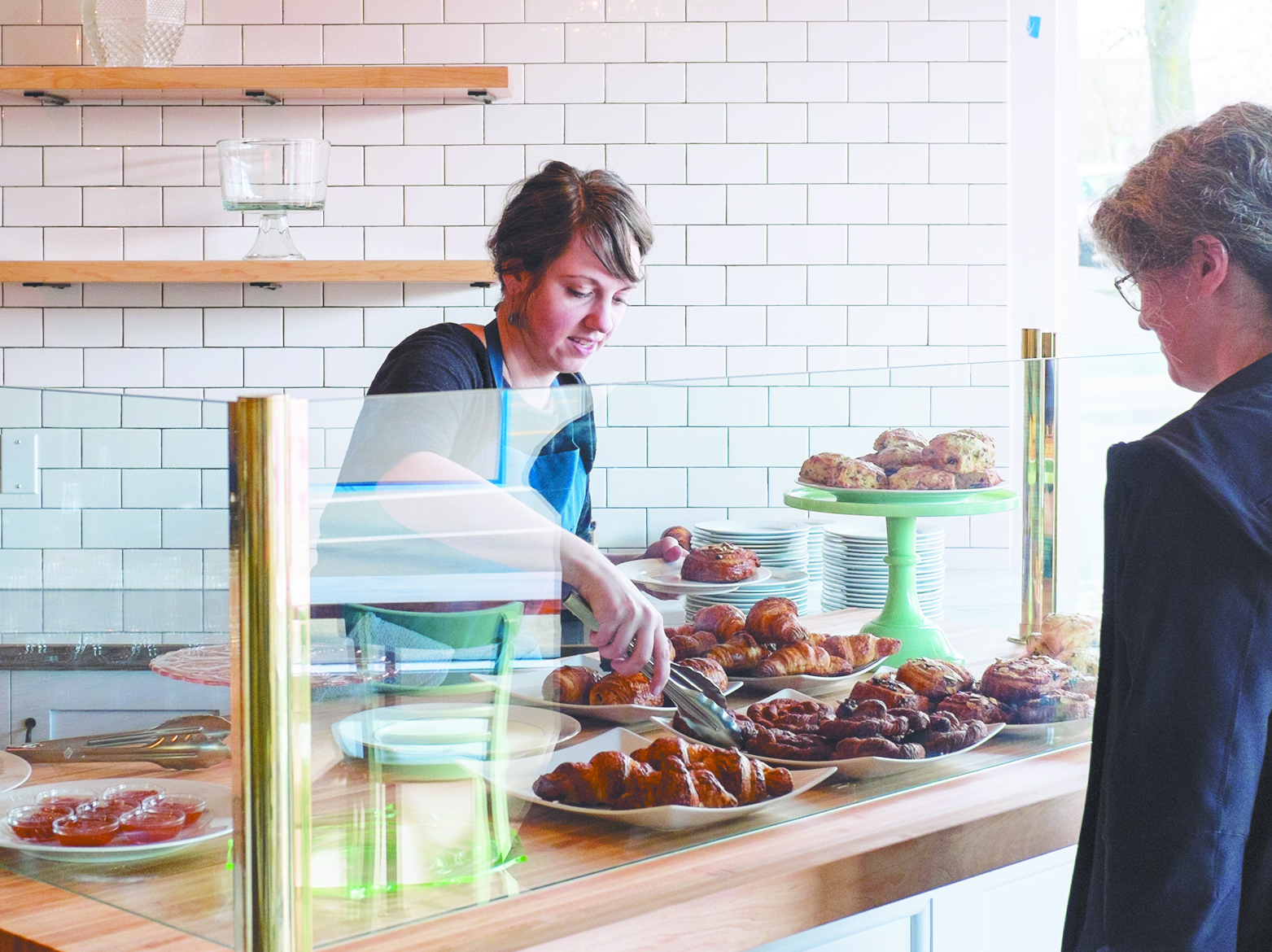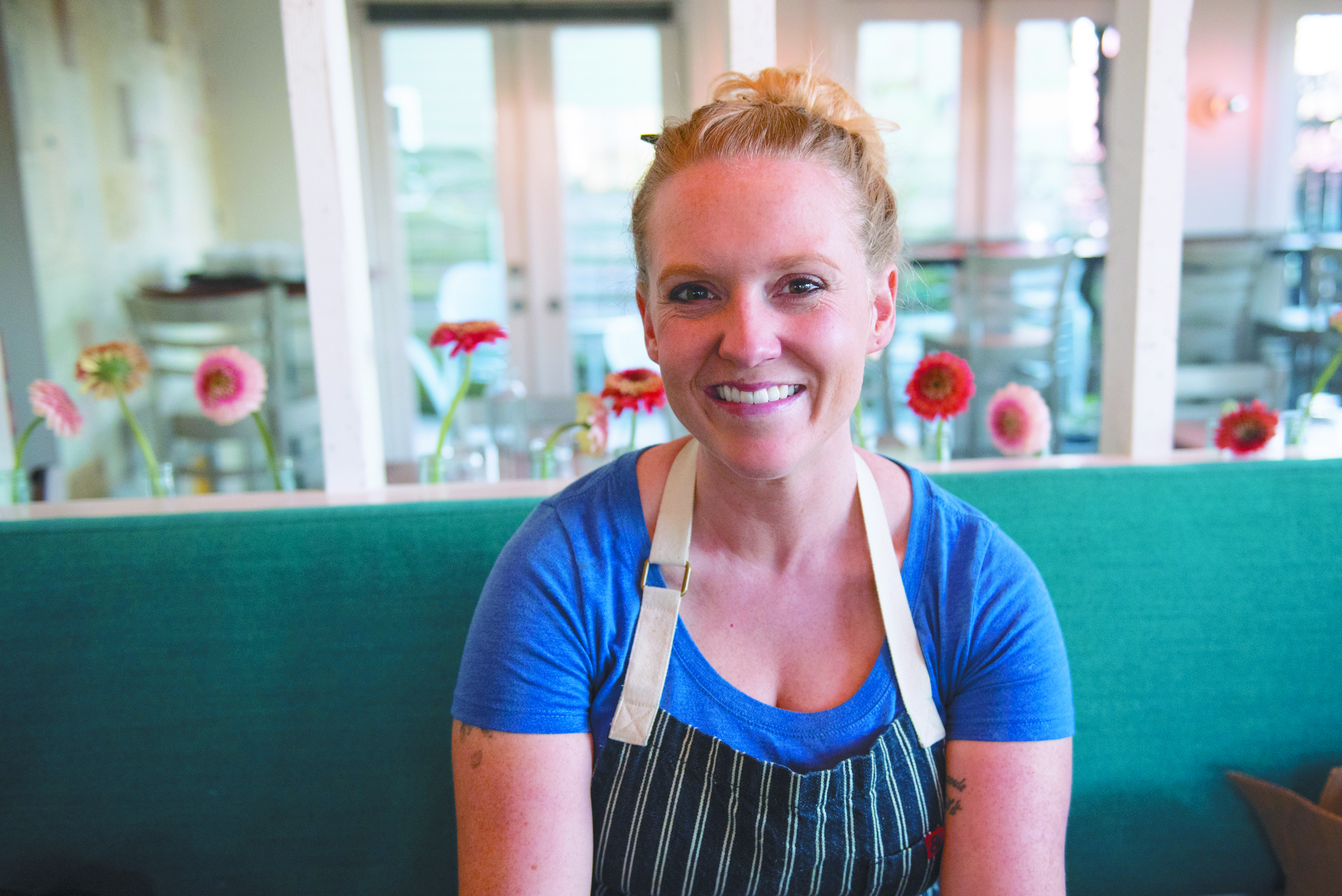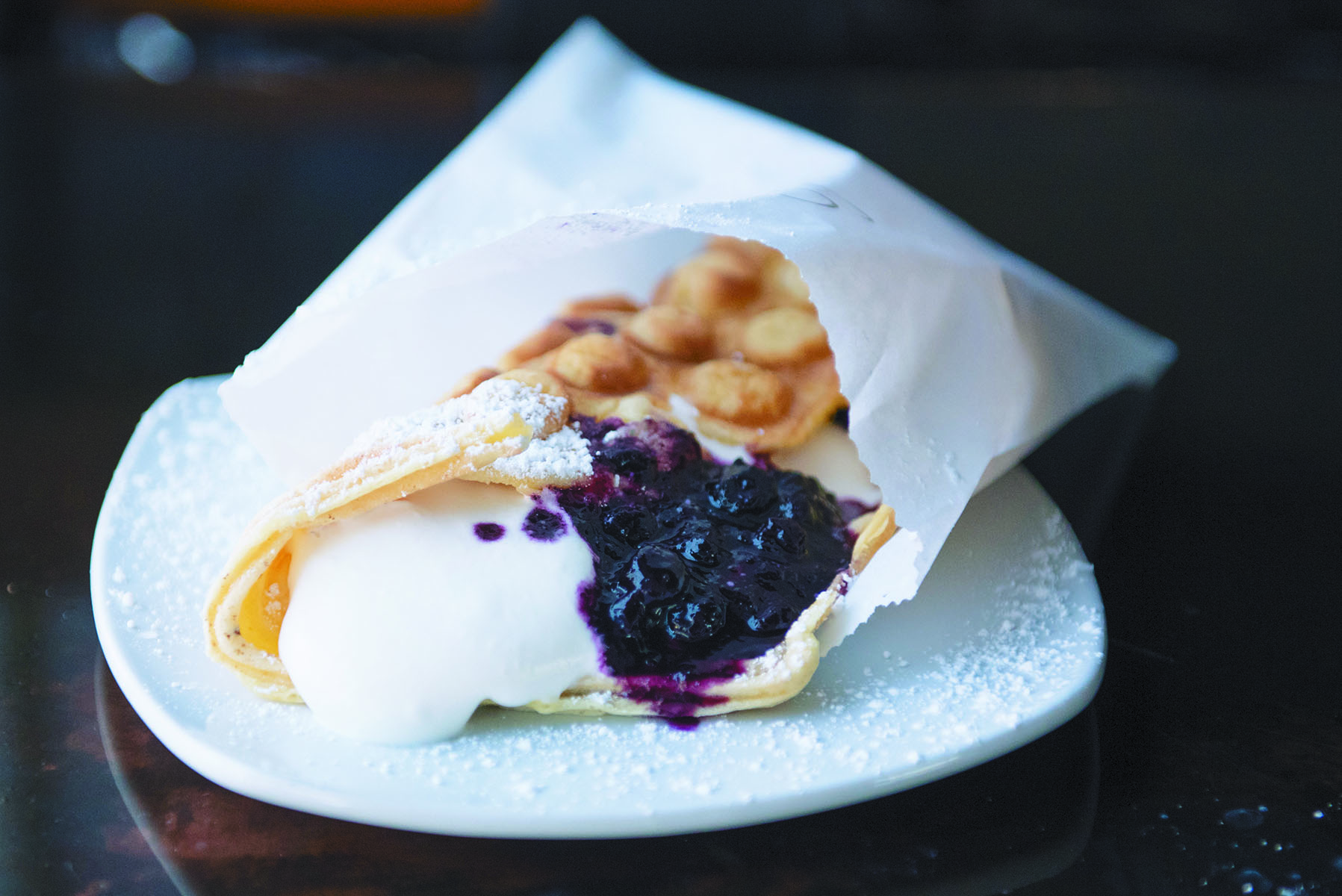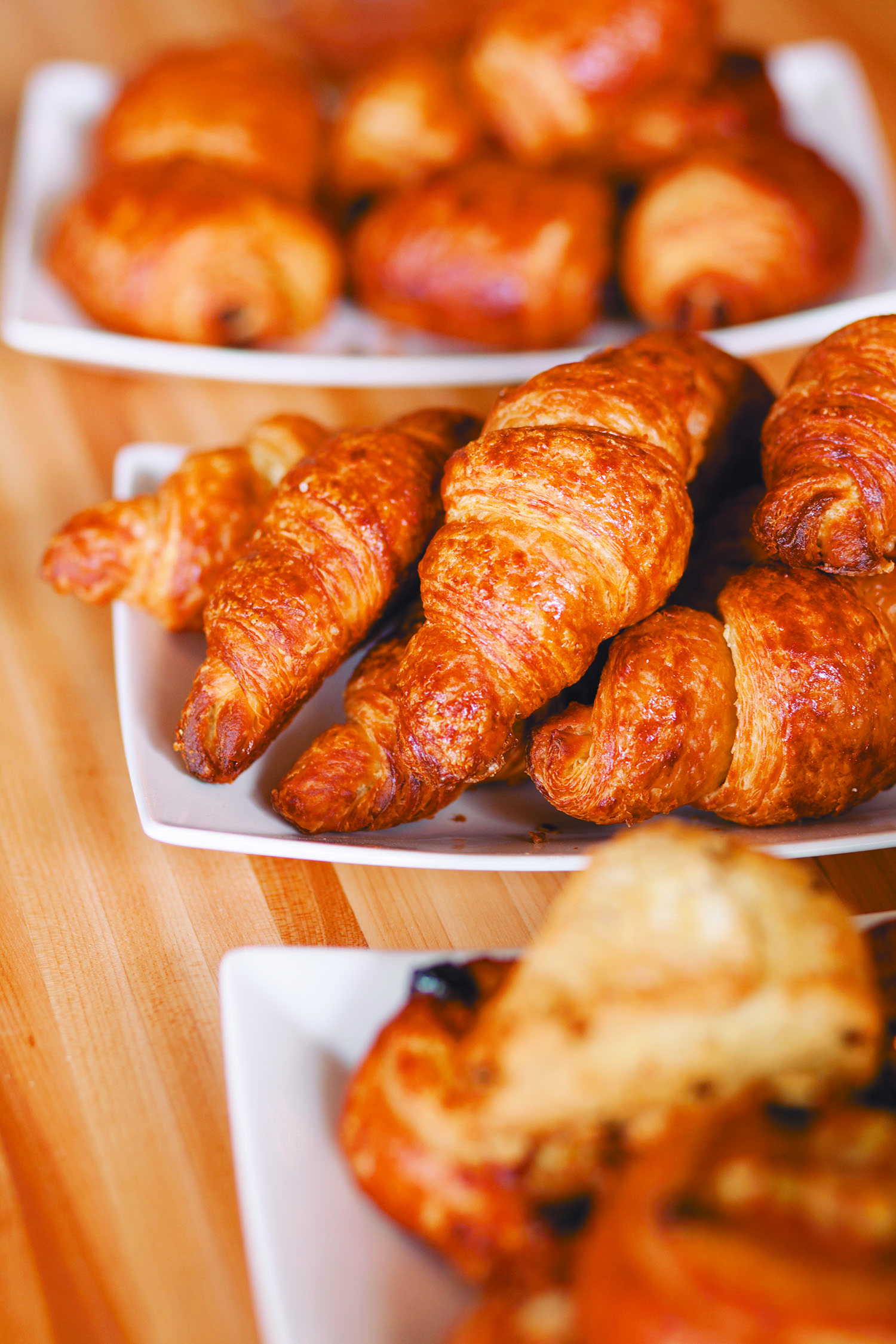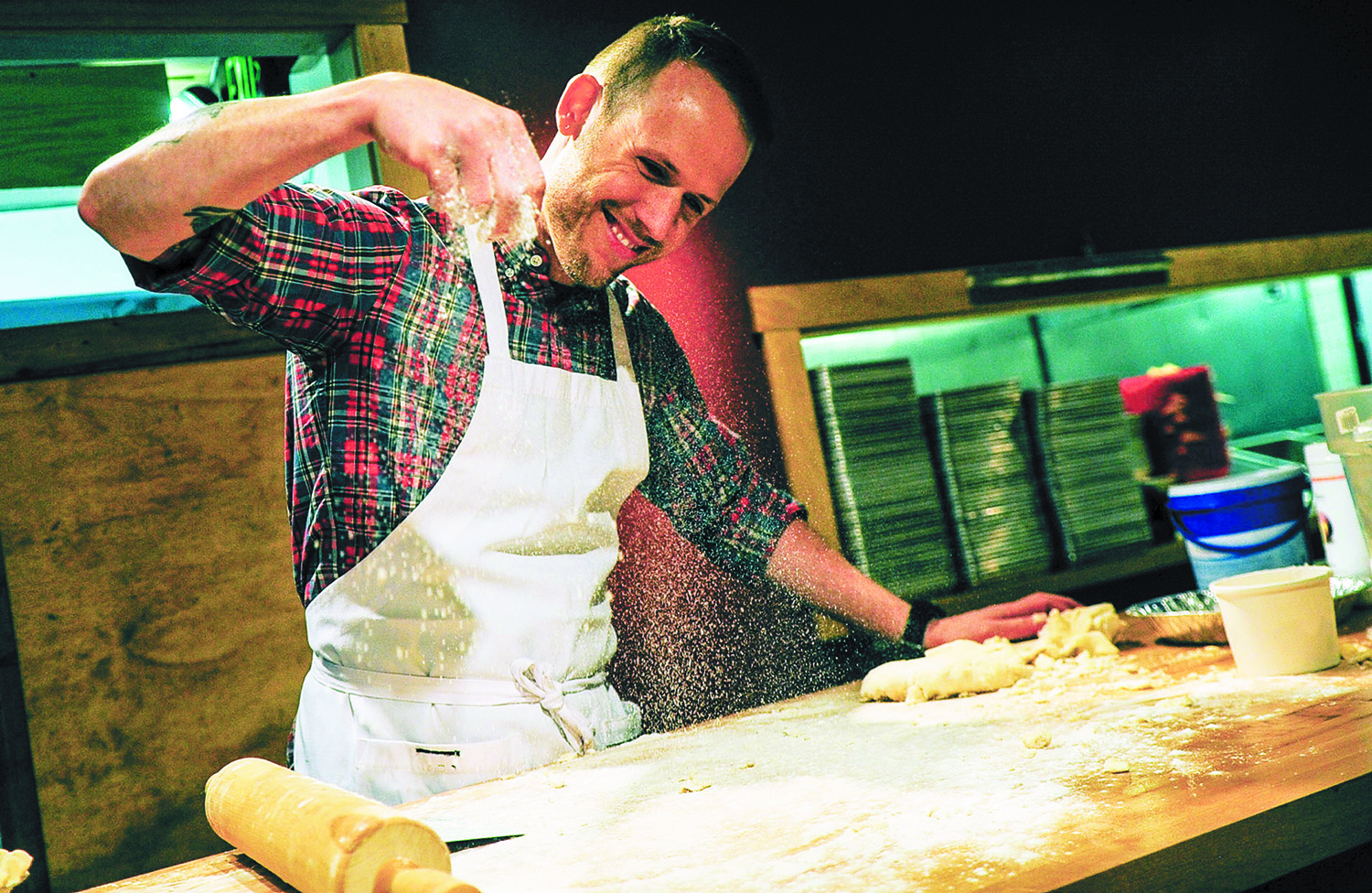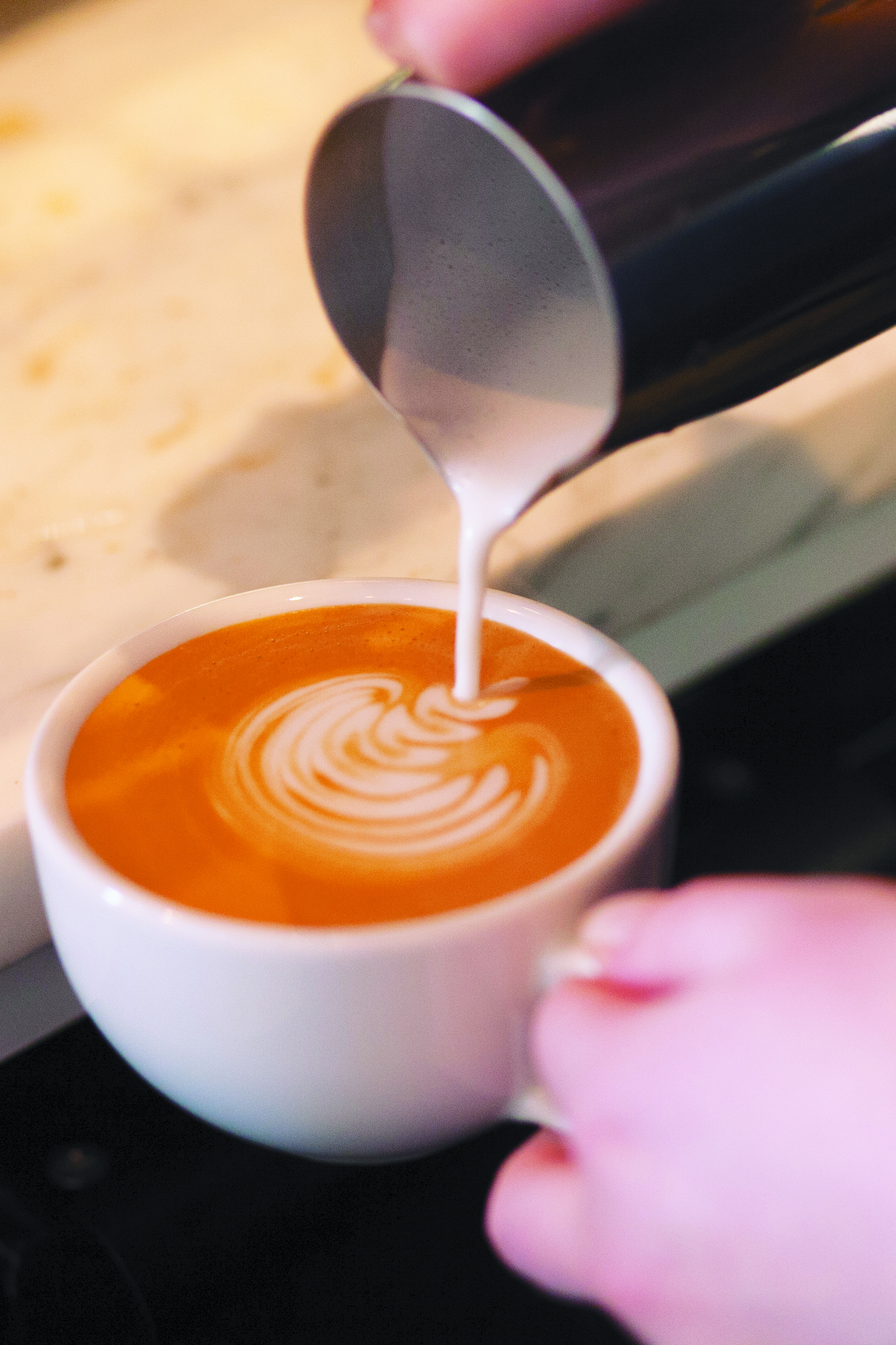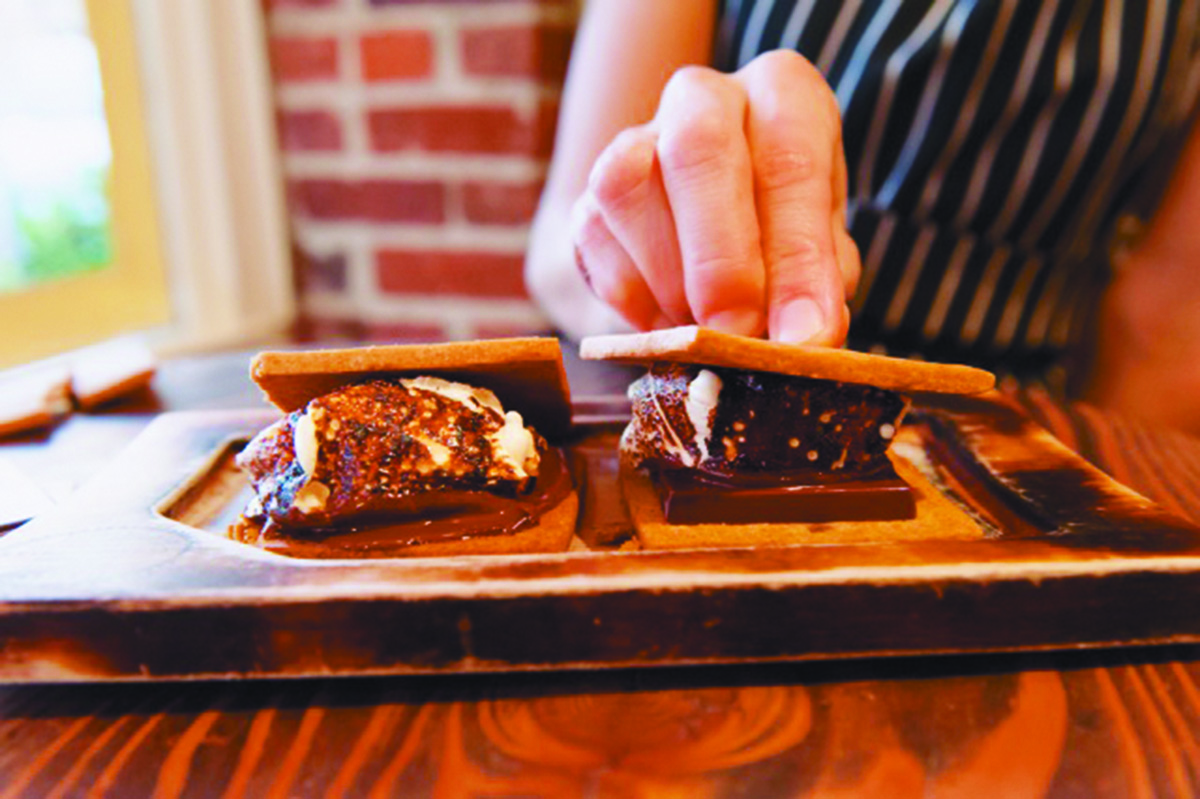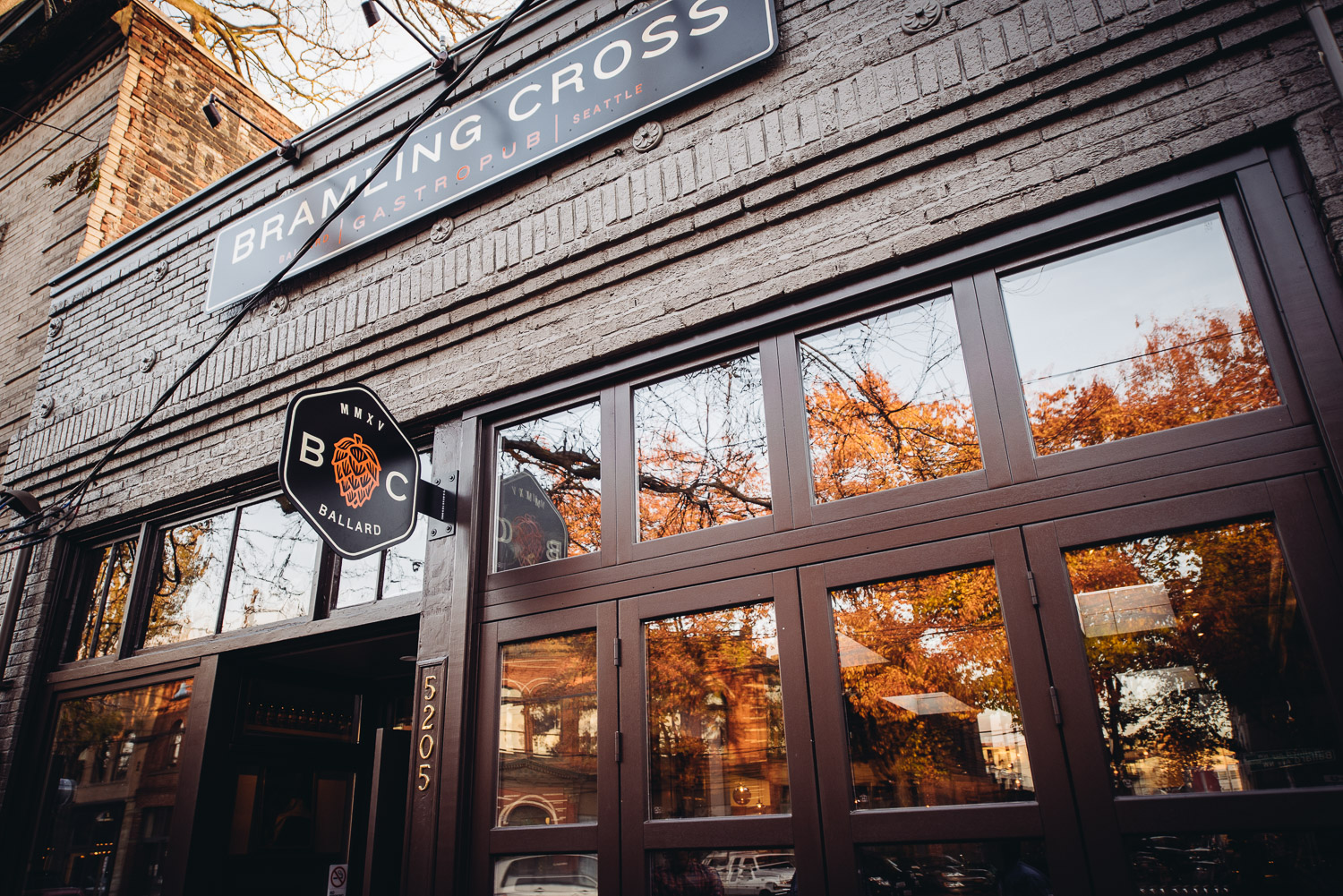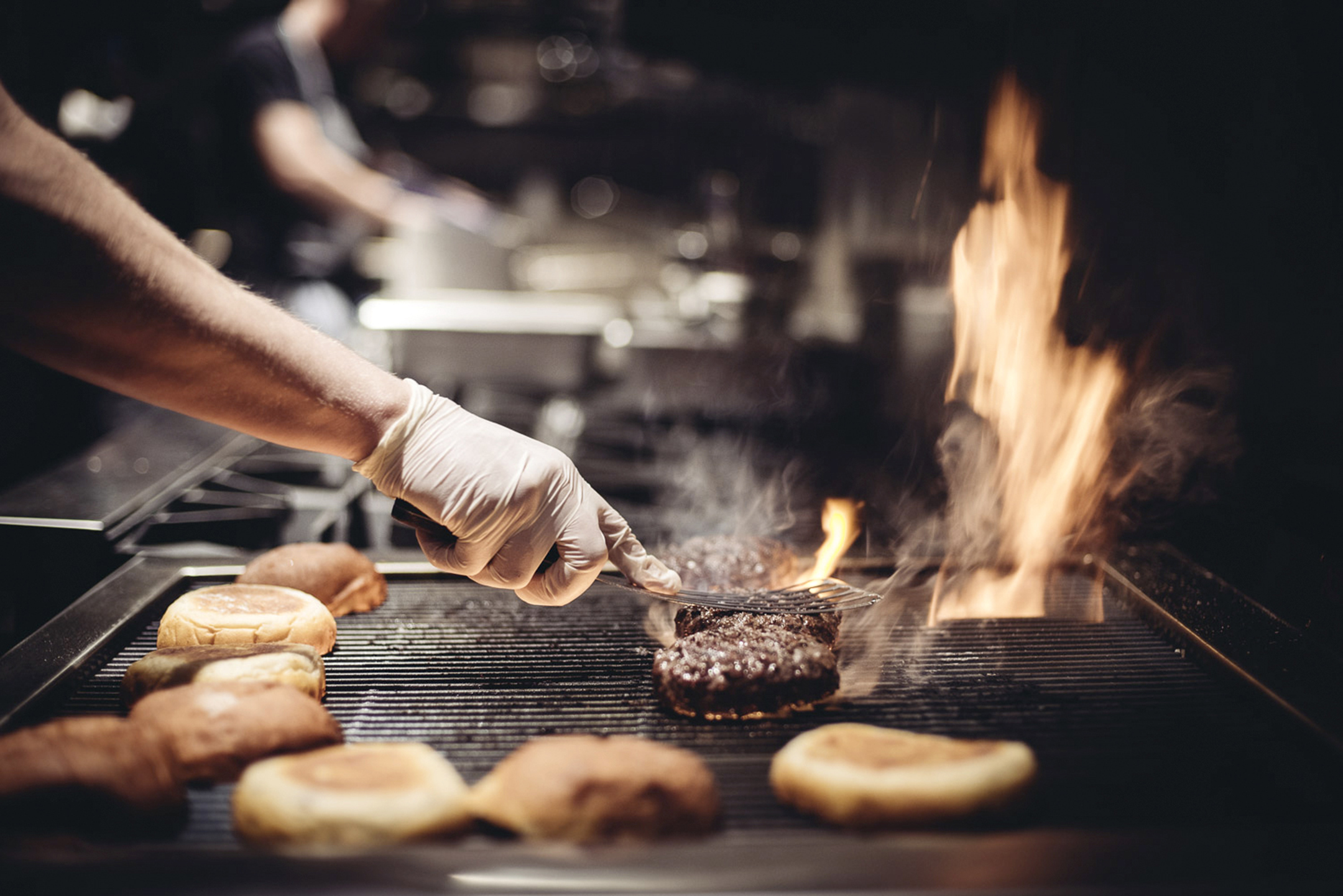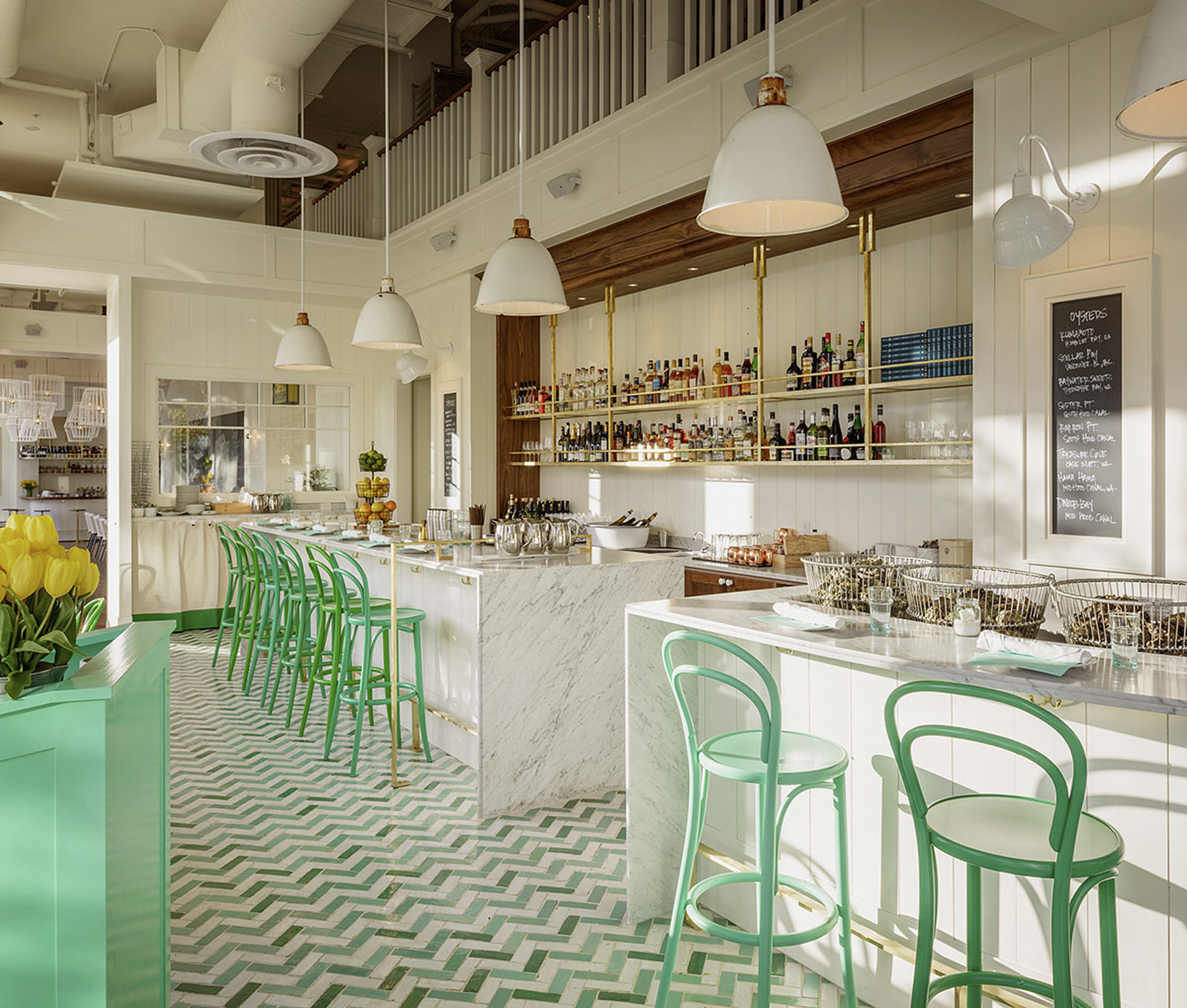To diners, the dessert might appear to be in decline. Restaurant dessert menus have shrunk in recent years, and they all bear a striking resemblance to one another. Donuts (or some version of them), mousses, puddings, and other chilled, jarred items are staples of the day. The reasons are obvious.
These desserts are easy to prepare in advance and have longer shelf-lives, two factors that are key for an economy in which most small Seattle restaurants can’t afford to employ a pastry chef. A recent Washington Post article about the unprofitable reality of desserts says “a cocktail brings in twice as much money and doesn’t hold up a table at the end of the meal.” Rachel Yang, owner of Joule and Revel, echoes that challenge. “Dessert is only $50 to $100 profit a night for a small restaurant,” she says. Such desserts also fit the current casual, small-plate style of dining that has swept not just Seattle but the whole country, as well as the resurgence in popularity of nostalgic childhood sweets. After a bout of “feasting and sharing” with friends, what place does a serious-minded, showstopping dessert really have? This is particularly true in a city where “fine dining,” with its more composed, plated desserts, never really existed to begin with, at least outside the Canlis/Book Bindery stratosphere.
Yet desserts are still as beloved as ever here; it’s just that diners are increasingly seeking niche eating experiences, places where they can get their sweets anytime, not just after a big meal. As a result, some of our city’s most pedigreed pastry chefs have struck out on their own, shaking up the sweet world to open unconventional bakeries, dessert pop-ups, and specialty shops. Most of them have trained at top culinary schools, done stints at world-renowned restaurants, and worked for either Canlis or Seattle’s patron saint of dessert service, Jerry Traunfeld of Herbfarm and Poppy. Here we bring you the Seattle Sweet Elite—and their latest and greatest.
It was at Revel and Joule where Laura Pyles, who currently runs her Parchment pop-up out of Brimmer & Heeltap on occasional weekend mornings, really hit her stride. There she had the chance to bring to the forefront her playful desserts, like chocolate peanut butter pie with a potato-chip crust. It was also there that she was introduced to more exotic, Asian flavors. “I really had a lot of creativity, but it was pretty intense because the dessert menu at Revel changed monthly, rather than seasonally.” Despite her success there, she left, her choice ultimately driven by what she calls the glass ceiling of the pastry world. “As a pastry chef you go into a restaurant in Seattle at the top of your game. There’s nowhere to go from there. For young chefs, it’s hard.”
Since leaving, she’s found a rabid clientele for items like cannoli filled with Mexican vanilla mascarpone and“Bubble Waffles,” a Hong Kong-style dessert that resembles a sheet of bubble wrap and consists of waffle batter made with custard powder. Also in demand are her mallorca buns, which she fell in love with at the famous, late La Bombonera breakfast spot in San Juan, P.R. These buttery, snail-shaped sweet buns are dusted with powdered sugar, but Pyles gives them a savory spin by adding eggs and bacon. Desserts with savory elements are another huge trend in the sweet world right now.
Despite her formal training in composed, plated desserts, Pyles loves the playful “stoner” desserts, like Cereal Milk and Crack Pie, which Christina Tosi of Momofuku Milk Bar in New York City made popular. Pyles is quick to point out that the techniques she learned in pastry school apply to “lowbrow” desserts too: working with laminated dough, making pastry creams, and the like. “Even when I was at Book Bindery doing fancy desserts, one of the most popular things was a fluffernutter cake with a malted banana milkshake. You shouldn’t have to hide in your own kitchen to eat these things,” she says. “When you’re by yourself in your underwear and all inhibitions are out the window, that’s the perfect kind of dessert.”
Coyle, who made a name for herself as pastry chef at Herbfarm (Jerry Traunfeld, check!), Le Pichet, and Cafe Presse before leaving restaurants to start a pop-up out of the bookstore Book Larder on weekends, drew lines that wrapped around the block and sold out of her passion-fruit tarts, toffee sticky pudding, and millionaire’s shortbread in less than an hour.
Coyle echoes Laura Pyles in her rationale for busting out on her own. “If you’re doing a good job in pastry, you raise through the ranks quickly in Seattle. At a certain point there’s no one to tell you how to do it better. It’s not like New York and France,” says Coyle, who went to culinary school in the former and worked in the latter. “There’s level upon level of mastery [there], and people around you with such refined skills. With pastry, as with so many things here in food—wine, cheese—we’re still playing catch-up. But there are good things about that. It gives you more flexibility to try things. You have to make your own challenges.”
Coyle is indeed doing just that: After a long, difficult process finding her own brick-and-mortar location, she finally opened Coyle’s Bakeshop in Greenwood in March. While you can’t pin her down to one style, unlike many of her pastry compatriots she is not a fan of the over-the-top stoner dessert.
“It’s very sweet for me. I feel like it celebrates something else that’s not food, and that’s not super-exciting to me,” she says. “There’s a lot of attachment to things I had as a child, like Funfetti. But I’d just have some Funfetti and not try to build on it.”
Coyle’s outstanding breakfast pastries and desserts play to her mastery of French technique as well as to her love of British pastry and American favorites like traditional layer cakes. She’s particularly fond of her French Paris-Brest: pate de choux with hazelnut cream and crunchy caramel on the outside, which she perfected at Le Pichet for a single customer who came in for it every Friday. “As I move forward with whatever my style of pastry is becoming, I’m really into fruit, the change of seasons and their flavors. That’s what’s exciting to me.” Us too!
Another JerryTraunfeld protege, Bumpas left Poppy just last year, where he made one of my favorite desserts in the city last summer: a sage custard tart with port cherries and goat-cheese ice cream. While my fixation with the dish was focused on its incredibly light, eggy custard and the play of the herbs and fruit, Bumpas was likely most excited about the ice cream. In fact, he’s left Poppy to start his own dessert pop-up, Sweet Bumpas—focused on, you guessed it, ice cream.
Like many of his entrepreneurial brethren, Bumpas first teamed with a local restaurant, Jack’s BBQ. But rather than just borrowing their space when they closed, he served a dessert course to follow barbecue dinners there. Barbecue and ice cream—does it get any better?
Unlike many of the pastry chefs profiled here, Bumpas went to culinary school to train as a regular chef, but during his schooling discovered that dessert was his passion. Early on, while working a catering job, he was doing a lot of bread baking and desserts. One day his boss said, “Don’t take this the wrong way, but I think you’re supposed to be a pastry chef.” After that, he worked the line at Poppy for four months before becoming the pastry chef there.
But like so many others, he hit a wall. “I felt frustration. Being a pastry chef in Seattle is such a low priority to everyone else in the kitchen. So even if I give clear instructions to the line cooks and show them how to plate the dessert, attention isn’t always paid to temperature and texture.” To challenge himself, he went to stage for a week with Poppy’s first superstar pastry chef, Dana Cree, a 2015 James Beard Award finalist now at Chicago’s Michelin-starred Blackbird. “Michelin style is not my style, but the techniques were great.”
Referring to the name Sweet Bumpas, he says, “That’s what the staff at Poppy called me, and it stuck. Ice cream and candies are really my passion. I often had a marshmallow and Turkish Delight at Poppy. I started doing pretty wacky flavors there. My savory background comes in; having my ice creams herb- and spice-heavy. I did a ginger ice cream with fermented black rice, and a burnt-honey ice cream with urfa biber [a Turkish spice].”
It’s been his dream to have his own shop for some time. “I just got my ice-cream machine yesterday. I’ll be focusing on sundaes, and baked items that go well with ice cream, like pie. [He tells us he’ll be selling them at new pop-ups and area farmers markets in May.] The ice-cream sandwiches are going to be very popular, I think. I did them as a filler once at Poppy, and they flew out of there. I said ‘I’ll pay the next server who doesn’t sell an ice-cream sandwich.’ They’re comforting and appealing, but I bring new flavors, like a banana-coconut ice-cream sandwich with pandan leaf and lime and a meringue marshmallow dip. Ice cream brings back memories of childhood, when you’re so giddy to get it and then cry when it falls on the floor.” Other favorites of ours: his classic chocolate chess pie with chipotle peanut-brittle ice cream and bourbon caramel, and his blackberry-basil marshmallows.
It’s hard to remember that Hot Cakes Molten Chocolate Cakery is only about two years old; the lines, the buzz, the crowds in both winter and summer speak to more of a Seattle institution. That’s likely because owner Autumn Martin is one.
From culinary school to pastry cook at Canlis, Martin’s pastry trajectory was pretty traditional—until she discovered that chocolate was her passion, and in 2004 became the chocolatier at what is now Theo Chocolate. It was there, she says, that “I started opening my eyes to which ingredients work well in the sweet kitchen,” and where she developed her signature molten chocolate cake in a Mason jar for a party on a farm—back when using Mason jars wasn’t a cliche. They were such a success, bringing in loads of private orders, that she decided to take them to farmers markets. “People seemed to really enjoy the product, and that got me excited.”
So in 2009 she resigned from Theo and focused on peddling her products at the Ballard Farmers Market, adding caramels, pocket pies, and the sauces she’s become famous for. Eventually, though, she realized that an outdoor market wasn’t serving her products well; chocolate is so temperature-sensitive. So after a stint working on an olive farm in Spain, Martin opened Hot Cakes’ brick-and-mortar shop in 2012. Her concept, a dessert restaurant that focused on evenings (as opposed to a bakery or patisserie with morning and lunch hours), hadn’t been done in Seattle, and she admits that “I love to be the first person to do something.” While drinking chocolate was not a new idea, she decided to develop a drinking caramel, putting a Hot Cakes boozy spin on it by adding mezcal.
Martin also quickly gained a reputation for her smoked chocolates. “Growing up, my dad did a lot of fishing and smoked steelhead and salmon, so I grew up with smokers out back all the time. It’s one of my most favorite flavors in the world and important to me for my family, so I needed to figure out how to do it in a sweet kitchen.” She’d tried it at Theo before, building a chocolate smoker there, but the smoked chocolate bar with sea salt and almond was a failure. “I loved it, but no one bought it. People weren’t into the sweet/savory thing yet. So I thought, OK, people, I’ll tuck this away and some day you’ll like it.” Indeed.
Fast forward a few years, when bacon became the rage in everything from cupcakes to ice cream. “I have a love/hate relationship with trends,” Martin says. “I do everything I can to go against them, but I love them because it allows people to finally appreciate the work I’m doing.” This time she smartly introduced her smoked chocolate in a classic childhood favorite, s’mores—a dessert that’s naturally smoky due to its campfire-style cooking.
Those s’mores continue to be a top seller, as are her grilled chocolate sandwiches (“Maybe the first experience when I thought chocolate and savory can actually work”), her boozy milkshakes, her spiked drinking caramels, and even her non-chocolate: seasonal fruit items like bread puddings and trifles, items that “let me showcase the fruit that’s grown here, to highlight the beautiful bounty of the state.”
Next up for Martin is a new Hot Cakes coming to Capitol Hill. Though originally planned to open this spring, she says that summer is a more realistic date. The timing will be perfect, since the new shop will have outdoor seating and an area where s’mores are grilled street-side. She’ll still carry her limited-edition salted-caramel products, like the Nettle Caramel sauce they sold this past spring, as well as two new ones that she couldn’t divulge at press time. Whatever they are, they’re sure to be groundbreaking. E
nsprinkle@seattleweekly.com
While the trend for solo shops is going strong, plenty of restaurants still maintain notable dessert programs. Rachel Yang, who now employs a pastry team of three for Revel, Joule, and Trove, says, “You see so many pastry chefs in bakeries now, but I have utmost respect for pastry chefs who work in restaurants. They’re always pushed around from place to place, on their own, trying to get oven space and make their presence. It’s not like a bakery where you have all morning in your own space, at the temperature you like. So pastry chefs who can survive in restaurants—that’s amazing.” Here’s a look at some of the best and the desserts that make them proudest.
Dionne Himmelfarb
, pastry director, Ethan Stowell Restaurants
Yes, she was the pastry chef at both Canlis and Poppy (her legacy at the latter is best summed up by her signature beet sundae). Now she creates and oversees desserts in all 10 of Stowell’s restaurants, where she continues to build on her knowledge of American and Italian flavors despite her Indonesian upbringing—and works to bring together the pastry community here in Seattle. What to try: The Tiramisu Shot at Rione XIII. A single serving in a glass of tiramisu cake layered atop a shot of espresso on the bottom, it’s meant to replicate a dessert from Rome. Dig your spoon through layers of mascarpone, ladyfingers, and cocoa powder, then throw back the shot of espresso at the end. Also, over at Red Cow she’s serving a rhubarb tart (the rhubarb is poached) with almond cream on the bottom and candied rhubarb on top. “Spring tonic,” according to my grandmother.
Renee Bolstad
, pastry chef, Revel, Joule, Trove
Taking over from Laura Pyles, Bolstad returned to Seattle after a stint at New York’s Spice Market (a Jean-Georges Vongerichten restaurant), and continues the sweet/savory, Asian-inflected pastry tradition that reflect these restaurants’ punchy, unexpected flavors. What to try:
Trove’s “mud pie” parfait, with coffee frozen custard, cardamom sponge cake, tahini sauce, and spiced chocolate almond toffee bits. What else to try: Joule’s cheesecake flavored with white truffle oil, walnut crust, and spiced pears. There’s so much going on, in the very best way.
Lucy DamkoeHler
, pastry chef, Sugar Mountain Bakeshop
Classically trained, she worked on the pastry team at New York’s Gramercy Tavern and at Vienna’s oldest bakery, Demel, dating back to the 1700s. Here in Seattle she honed her skills at Andaluca, Mistral Kitchen, TASTE at SAM, and Hot Cakes. Now her whimsical takes on French techniques can be found at Pasta & Co., Liam’s, and Bennet’s—restaurants she outsources to. What to try: Peanut butter & jelly cake. A peanut-butter cake with strawberry jam and peanut-butter mousse, it brings the best of childhood to the adult palate.
Stacy Fortner
, pastry director, Tom Douglas Restaurants
She’s worked in restaurants all over the country, including Mamnoon in Seattle, and traveled extensively throughout South America before settling in six years ago with T.D., where she’s responsible for desserts at his 16 restaurants (!). What to try: Beyond the obvious—and delicious—triple coconut-cream pie that Tom Douglas fans adore, Fortner created a Greek cheesecake for Lola: Greek yogurt mousse with rosewater or orange-blossom water is layered atop semolina pudding, then garnished with shredded phyllo dough and nuts and spices. Plated around it are seasonal fruits—blood orange and vanilla in the winter, currants or strawberries in the spring. What else to try: For Douglas’s recently opened Mexican restaurant, Cantina Lena, Fortner puts out an exceptionally fine Mexican caramel flan that changes in flavor; you might get one infused with lime, or one with vanilla bean.
Jerry Traunfeld
, owner/chef, Poppy
Traunfeld admits that “In terms of dollars we sell in desserts, it doesn’t make sense to have a pastry chef,” but it’s important for “the overall picture of what we are.” A trained pastry chef, Traunfeld did desserts at Herbfarm for 10 years before becoming executive chef and opening Poppy, the city’s incubator for many top pastry talents. He continues to bring exciting flavors—from varied herbs, in particular—into the desserts there, and really solidified that trend in Seattle. What to try: You can’t go wrong with the Hot Date Cake with butterscotch, pecans, and banana ice cream; it put the restaurant on the map as a dessert destination. What else to try: But also go for a newer incarnation like a chocolate hazelnut brulee with spice cake and candied orange, which harmoniously marries sweet, spicy, and bitter. E
nsprinkle@seattleweekly.com
